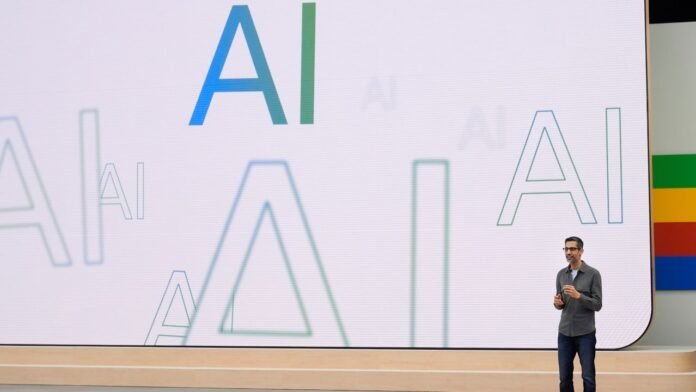Google has issued its 2024 Environmental Report, a more than 80-page document describing the massive company’s efforts to apply tech to environmental issues and mitigate its contributions. But it dodges how much energy AI uses—perhaps because the answer is “way more than we’d care to say.”
Noteworthy Initiatives
You can read the full report here (PDF); honestly, it’s got a lot of exciting stuff. It’s easy to forget how many plates a company as big as Google keeps spinning, and there is some noteworthy work here.
AI Water Replenishment Program
For instance, it’s been working on a water replenishment program, hoping to offset the water used in its facilities and operations, eventually creating a net positive. This is done by identifying and funding watershed restoration, irrigation management, and other work in that area, with dozens of such projects worldwide being partially bankrolled by Google. It’s gotten to 18% of its water usage replenished (by whatever definition of that word is used here) that way and is improving every year.
AI in Climate Solutions
The company also takes great care to frontload the potential benefits of AI in climate, such as optimizing watering systems, creating more fuel-efficient routes for cars and boats, and predicting floods. We’ve highlighted a few of these already in our AI coverage, and they could be pretty helpful in many areas. Google doesn’t have to do this stuff, and many large companies don’t, so credit where credit’s due.
Managing AI’s Resource Consumption
Then, we reach the section “Responsibly managing the resource consumption of AI.” Here, Google, so sure of every statistic and estimate until now, suddenly spreads its hands and shrugs. How much energy does AI use? Can anyone be sure?
Downplaying Data Center Energy Usage
Yet it must be wrong because the company first downplays the entire data center energy market, saying it’s only 1.3% of global energy usage. The amount of energy Google uses is only, at most, 10% of that—so only 0.1% of all the energy in the world is powering its servers, according to the report. A trifle!
AI Rising Emissions
In 2023, our total GHG [greenhouse gas] emissions were 14.3 million tCO2e, representing a 13% year-over-year increase and a 48% increase compared to our 2019 target base year. This result was primarily due to increased data center energy consumption and supply chain emissions. As we further integrate AI into our products, reducing emissions may be challenging due to increasing energy demands from the greater intensity of AI computing and the emissions associated with the expected increases in our technical infrastructure investment.
The Complexity of AI’s Environmental Impact
Yet the growth of AI is lost among the uncertainties above. Google has the following excuse for why the company is not being specific about the contribution of AI workloads to its general data center energy bill:
Predicting AI’s future environmental impact is complex and evolving, and our historical trends likely don’t fully capture AI’s future trajectory. As we deeply integrate AI across our product portfolio, the distinction between AI and other workloads will not be meaningful. So, we’re focusing on data center-wide metrics since they include AI’s overall resource consumption (and hence, the environmental impact).
Obfuscation of Figures
“Complex and evolving”; “the trends don’t likely fully capture”; “the distinction … will not be meaningful”: This is the kind of language used when someone knows something but would prefer not to tell you.
The Cost of AI
Does anyone believe Google doesn’t know, down to the penny, how much AI training and inference have added to its energy costs? Isn’t being able to break down those figures so precisely part of the company’s core competency in cloud computing and data center management? It has all these other statements about how efficient its custom AI server units are, how it’s doing all this work to reduce the energy required to train an AI model by 100x, and so on.

Conclusion: Green Efforts vs. Energy Costs
I have no doubt Google is making many great green efforts, and you can read about them in the report. But it’s important to highlight what it seemingly refuses to: AI systems’ enormous and growing energy cost. The company may not be the primary driver of global warming, but despite its potential, Google doesn’t seem to be at a net positive.
The Need for Transparency
Google has every incentive to downplay and obfuscate these figures, which can hardly be good, even in its reduced, highly efficient stand. We’ll ask Google to get more specific before we find out whether they get even worse in the 2025 report.


